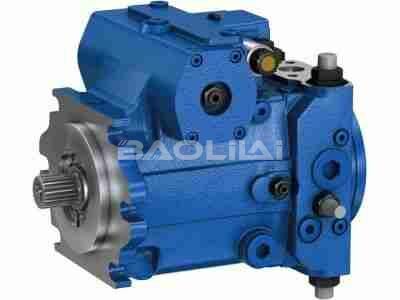Master the installation skills of hydraulic oil pumps to ensure smooth operation of the system
The installation location of the hydraulic oil pump in the tank depends on the specific design and requirements of the hydraulic system. However, there are some general guidelines to follow:
1. Immersion installation:
In many hydraulic systems, the hydraulic pump is directly submersed in hydraulic fluid (oil). This type of installation helps cool the pump and reduces noise.
The pump is usually located at the bottom of the tank to allow easy suction of oil.
A filter or strainer is usually installed at the pump inlet to prevent debris from entering the pump.
2. Top installation:
In some systems, the hydraulic pump is mounted on top of the tank.
This type of installation is common in systems where the pump must be kept accessible for maintenance and repair.
Use external pipe or hose to connect the pump to the oil in the tank.
3. Intermediate installation:
In some cases, the pump can be mounted centrally within the tank.
This type of installation can provide a balance between ease of access and the advantages of underwater installation.
4. External reservoir:
In some hydraulic systems, the pump is not located within the tank but is connected to an external tank.
The pump draws oil from the external tank through the suction pipe.
5. Cooling precautions:
Hydraulic pumps generate heat during operation. Consideration should be given to a cooling pump to prevent overheating.
Immersing the pump in oil provides natural cooling, but in some applications additional cooling methods may be required, such as an external heat exchanger.
H1-P-060-R-A-A-A4-C2-N-D6-H-G1-H2-L-28-L-20-F-L-20-PN-NNN-NNN H1P060RAAA4C2ND6HG1H2L28L20FL20PNNNNNNN
H1-P-060-R-A-A-A4-C2-N-D6-H-F1-H3-L-42-L-42-C-L-24-PN-NNN-NNN H1P060RAAA4C2ND6HF1H3L42L42CL24PNNNNNNN
H1-P-060-R-A-A-A4-C2-N-D3-H-G1-H2-L-35-L-35-C-M-20-PN-NNN-NNN H1P060RAAA4C2ND3HG1H2L35L35CM20PNNNNNNN
H1-P-060-R-A-A-A4-C2-B-F5-H-F1-H6-L-33-L-33-F-P-22-PN-NNN-NNN H1P060RAAA4C2BF5HF1H6L33L33FP22PNNNNNNN
H1-P-060-R-A-A-A4-C2-B-D8-H-G1-NN-L-33-L-33-F-P-22-PN-NNN-NNN H1P060RAAA4C2BD8HG1NNL33L33FP22PNNNNNNN
H1-P-060-R-A-A-A4-C2-B-D8-H-G1-NN-K-33-K-33-F-P-24-PN-NNN-NNN H1P060RAAA4C2BD8HG1NNK33K33FP24PNNNNNNN
H1-P-060-R-A-A-A4-C2-B-D6-H-G1-H2-L-30-L-30-C-L-24-PN-NNN-NNN H1P060RAAA4C2BD6HG1H2L30L30CL24PNNNNNNN
H1-P-060-R-A-A-A4-C2-B-D3-H-G1-H2-L-33-L-33-F-M-24-PN-NNN-NNN H1P060RAAA4C2BD3HG1H2L33L33FM24PNNNNNNN
H1-P-060-R-A-A-A4-C2-B-D3-H-F1-H5-L-42-L-42-C-M-24-PN-NNN-NNN H1P060RAAA4C2BD3HF1H5L42L42CM24PNNNNNNN
H1-P-060-R-A-A-A4-C1-N-F5-H-F1-H6-L-35-L-35-C-P-24-PN-NNN-NNN H1P060RAAA4C1NF5HF1H6L35L35CP24PNNNNNNN
H1-P-060-R-A-A-A4-C1-N-D8-K-G1-H1-L-42-L-42-F-P-24-P4-NNN-NNN H1P060RAAA4C1ND8KG1H1L42L42FP24P4NNNNNN
H1-P-060-R-A-A-A4-C1-N-D8-H-G1-H2-L-35-L-35-C-P-24-PN-NNN-NNN H1P060RAAA4C1ND8HG1H2L35L35CP24PNNNNNNN
H1-P-060-R-A-A-A4-C1-N-D6-H-G1-NN-L-42-L-42-C-L-24-PN-NNN-NNN H1P060RAAA4C1ND6HG1NNL42L42CL24PNNNNNNN
H1-P-060-R-A-A-A4-C1-N-D6-H-G1-H3-L-42-L-42-C-L-24-PN-NNN-NNN H1P060RAAA4C1ND6HG1H3L42L42CL24PNNNNNNN
H1-P-060-R-A-A-A4-C1-N-D6-H-G1-H3-L-42-L-30-C-L-30-PN-NNN-NNN H1P060RAAA4C1ND6HG1H3L42L30CL30PNNNNNNN
H1-P-060-R-A-A-A4-C1-N-D6-H-G1-H3-L-38-L-38-F-L-24-PN-NNN-NNN H1P060RAAA4C1ND6HG1H3L38L38FL24PNNNNNNN
H1-P-060-R-A-A-A4-C1-N-D6-H-G1-H3-L-35-L-35-C-L-24-PN-NNN-NNN H1P060RAAA4C1ND6HG1H3L35L35CL24PNNNNNNN
H1-P-060-R-A-A-A4-C1-N-D6-H-G1-H3-L-30-L-42-C-L-30-PN-NNN-NNN H1P060RAAA4C1ND6HG1H3L30L42CL30PNNNNNNN
H1-P-060-R-A-A-A4-C1-N-D6-H-F1-NN-L-38-L-38-C-L-24-PN-NNN-NNN H1P060RAAA4C1ND6HF1NNL38L38CL24PNNNNNNN
H1-P-060-R-A-A-A4-C1-B-F4-H-G1-H6-L-25-L-25-C-M-28-PN-NNN-NNN H1P060RAAA4C1BF4HG1H6L25L25CM28PNNNNNNN
6. Vibration and noise:
Proper installation and isolation techniques should be used to minimize vibration and noise generated by the pump.
Vibration can affect pump performance and cause premature wear, so it is vital that the pump is adequately secured.
7. Maintenance access:
Regardless of the installation location, ensure adequate access for maintenance and repair activities.
Routine maintenance, such as checking and replacing filters, checking seals and monitoring oil quality, is critical to the longevity and efficiency of your hydraulic system.
8. Prevent air entrapment:
The pump should be positioned to minimize the risk of air entrainment in the hydraulic fluid.
Trapped air in hydraulic systems can cause performance issues and damage components, so it is critical to design your system to minimize this risk.
9.Pump direction:
Please note the manufacturer's recommendations regarding the allowable orientation of the pump.
Some pumps may have specific requirements for their mounting location or orientation for optimal performance.
10. Oil return path:
Ensure that the hydraulic fluid returning from the system to the tank does not create turbulence or aeration that could negatively affect pump performance.
Baffles or other design features can be used to effectively direct return oil.

11. Oil level monitoring:
Implement a reliable oil level monitoring system to ensure that the pump always has an adequate supply of hydraulic oil.
Maintaining the correct oil level is critical to proper pump operation and service life.
12. Temperature control:
Monitor and control the temperature of the hydraulic oil in the tank to prevent overheating.
Consider using temperature sensors and auxiliary cooling systems as needed to maintain optimal operating temperatures.
13. Anti-cavitation measures:
Cavitation occurs when the pressure in the pump falls below the vapor pressure of the hydraulic oil, causing cavities or bubbles to form. This may cause damage to the pump.
Proper pump sizing, maintaining adequate fluid levels, and using proper suction line size are critical to preventing cavitation.
14.Sealing integrity:
Make sure seals and gaskets are in good condition to prevent oil leaks. Oil leaks not only cause inefficiency but also contamination of the hydraulic system.
15. Electrical safety:
If the pump is electric, make sure all electrical components are installed according to safety standards.
Take precautions to protect against water intrusion and other potential electrical hazards.
H1-P-060-R-A-A-A4-C1-B-F4-H-F1-H6-L-35-L-35-F-M-24-PN-NNN-NNN H1P060RAAA4C1BF4HF1H6L35L35FM24PNNNNNNN
H1-P-060-R-A-A-A4-C1-B-D8-H-G1-NN-L-20-L-20-C-P-20-PN-NNN-NNN H1P060RAAA4C1BD8HG1NNL20L20CP20PNNNNNNN
H1-P-060-R-A-A-A4-C1-B-D3-H-G1-H3-L-35-L-35-F-M-24-PN-NNN-NNN H1P060RAAA4C1BD3HG1H3L35L35FM24PNNNNNNN
H1-P-060-R-A-A-A4-C1-B-D3-H-G1-H3-L-35-L-35-C-M-24-PN-NNN-NNN H1P060RAAA4C1BD3HG1H3L35L35CM24PNNNNNNN
H1-P-060-R-A-A-A4-C1-B-D3-H-G1-H3-L-25-L-25-C-M-28-PN-NNN-NNN H1P060RAAA4C1BD3HG1H3L25L25CM28PNNNNNNN
H1-P-060-R-A-A-A4-C1-B-D3-H-G1-H1-L-25-L-25-C-M-28-PN-NNN-NNN H1P060RAAA4C1BD3HG1H1L25L25CM28PNNNNNNN
H1-P-060-R-A-A-A3-C2-N-D8-H-G1-H3-L-42-L-42-N-E-26-PN-NNN-NNN H1P060RAAA3C2ND8HG1H3L42L42NE26PNNNNNNN
H1-P-060-R-A-A-A3-C2-N-D8-H-G1-H3-L-40-L-30-N-E-26-PN-NNN-NNN H1P060RAAA3C2ND8HG1H3L40L30NE26PNNNNNNN
H1-P-060-R-A-A-A3-C2-N-D8-H-F1-H5-L-30-L-30-C-P-20-PN-NNN-NNN H1P060RAAA3C2ND8HF1H5L30L30CP20PNNNNNNN
H1-P-060-R-A-A-A3-C2-N-D3-H-G1-NN-L-42-L-42-C-M-24-PN-NNN-NNN H1P060RAAA3C2ND3HG1NNL42L42CM24PNNNNNNN
H1-P-060-R-A-A-A3-C2-B-D3-H-G1-NN-L-42-L-42-C-M-24-PN-NNN-NNN H1P060RAAA3C2BD3HG1NNL42L42CM24PNNNNNNN
H1-P-060-R-A-A-A3-C1-N-F5-H-G1-H6-L-42-L-42-N-E-22-PN-NNN-NNN H1P060RAAA3C1NF5HG1H6L42L42NE22PNNNNNNN
H1-P-060-R-A-A-A3-C1-N-F5-H-G1-H6-L-42-L-42-N-E-20-PN-NNN-NNN H1P060RAAA3C1NF5HG1H6L42L42NE20PNNNNNNN
H1-P-060-R-A-A-A3-C1-N-D8-H-G1-NN-K-38-K-30-C-P-26-PN-NNN-NNN H1P060RAAA3C1ND8HG1NNK38K30CP26PNNNNNNN
H1-P-060-R-A-A-A3-C1-N-D8-H-G1-NN-K-35-K-35-C-P-26-PN-NNN-NNN H1P060RAAA3C1ND8HG1NNK35K35CP26PNNNNNNN
H1-P-060-R-A-A-A3-C1-N-D8-H-G1-NN-K-35-K-18-C-P-26-PN-NNN-NNN H1P060RAAA3C1ND8HG1NNK35K18CP26PNNNNNNN
H1-P-060-R-A-A-A3-C1-N-D8-H-G1-NN-K-30-K-30-C-P-26-PN-NNN-NNN H1P060RAAA3C1ND8HG1NNK30K30CP26PNNNNNNN
H1-P-060-R-A-A-A3-C1-N-D8-H-G1-H3-L-42-L-42-N-E-24-PN-NNN-NNN H1P060RAAA3C1ND8HG1H3L42L42NE24PNNNNNNN
H1-P-060-R-A-A-A3-C1-N-D8-H-G1-H2-L-42-L-42-N-E-20-PN-NNN-NNN H1P060RAAA3C1ND8HG1H2L42L42NE20PNNNNNNN
H1-P-060-R-A-A-A3-C1-B-F6-H-F1-H6-L-35-L-35-F-L-24-PN-NNN-NNN H1P060RAAA3C1BF6HF1H6L35L35FL24PNNNNNNN
16. Material compatibility:
Verify that the materials used in the pump and related components are compatible with the hydraulic fluid to prevent corrosion and degradation over time.
17. Gravity feeding system:
In systems where gravity assists the flow of hydraulic oil, consider the height of the tank and design the system to utilize gravity for optimal pump performance.
18. Emergency shutdown:
Implement an emergency shutdown mechanism to quickly stop the pump in the event of an emergency or malfunction.
19. Water tank size and shape:
The size and shape of the tank affects the overall performance of the hydraulic system. Design tanks to provide stable fluid conditions and minimize turbulence.
20. Regulatory Compliance:
Ensure hydraulic system installation complies with relevant industry standards and regulations.
Keep in mind that these guidelines are general in nature and the specific requirements for hydraulic pump installation may vary depending on the type of pump, hydraulic system design and application. Always refer to the documentation provided by the pump manufacturer and seek professional advice if needed. Regular inspection and maintenance are key to ensuring reliable, efficient operation of your hydraulic system.
This article is published by the official website of Baolilai Hydraulics, please contact the author and indicate the source for reprinting:https://www.baolilai-pump.cn/news/1173.html






